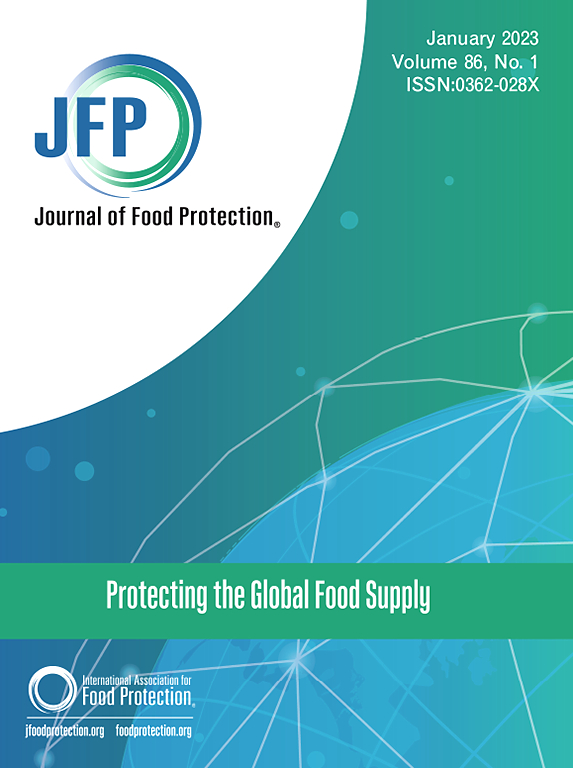海产品中致病性希瓦氏菌的流行、耐药性及控制。
IF 2.8
4区 农林科学
Q3 BIOTECHNOLOGY & APPLIED MICROBIOLOGY
引用次数: 0
摘要
一些希瓦氏菌属已被列为新兴病原体,对食品安全构成威胁。已知雪瓦氏菌藻类和腐烂雪瓦氏菌等物种会因接触海洋而引起软组织坏死和侵袭性感染。海鲜消费与希瓦氏菌病有关,引发了对公共卫生风险的担忧。近年来,由于海鲜的益处和消费者对健康和营养的总体积极看法,海鲜的消费量一直在上升。然而,一种新兴的海产品病原体,希瓦氏菌威胁着这些产品的安全。本综述综合了以下方面的现有数据:1)世界各地牡蛎和海水中潜在致病性希瓦氏菌的流行情况,2)来自不同地理区域的分离株的抗生素耐药性概况,以及3)减少海产品中希瓦氏菌的加工处理。研究结果表明,希瓦氏菌在海产品和海洋环境中广泛存在。研究还表明,随着时间的推移,希瓦氏菌对β-内酰胺类抗生素(如青霉素、氨苄西林和万古霉素)的耐药性越来越强。这种不断增长的抗生素耐药性主要归因于水产养殖和农业中抗生素的过度使用和误用,导致海产品中出现多重抗生素耐药(MAR)细菌。MAR细菌的存在限制了在发生希瓦氏菌和其他致病菌感染时的治疗选择,强调需要在海产品生产中采取更好的控制措施,以确保公共卫生安全。本文章由计算机程序翻译,如有差异,请以英文原文为准。
Prevalence, Antibiotic Resistance, and Control of Pathogenic Shewanella in Seafoods
Some Shewanella spp. have been classified as emerging pathogens and are a concern for food safety. Species such as Shewanella algae and Shewanella putrefaciens are known to cause soft tissue necrosis and invasive infections from marine exposure. Seafood consumption has been linked to Shewanella illnesses, raising concerns about public health risks. Seafood consumption has been on the rise in recent years due to its reported benefits and overall positive health and nutritional perception of consumers. However, an emerging seafood pathogen, Shewanella spp., threatens the safety of these products. This review synthesizes existing data on: (i) the prevalence of potentially pathogenic Shewanella spp. in oysters and seawater from locations around the world, (ii) the antibiotic resistance profiles of isolates from diverse geographic regions, and (iii) processing treatments to reduce Shewanella in seafoods. Findings suggest that Shewanella spp. are widespread in seafood and marine environments. Studies have also shown that over time Shewanella spp. have become more resistant to β-lactam antibiotics such as penicillin, ampicillin, and vancomycin. This growing antibiotic resistance is largely attributed to the overuse and misuse of antibiotics in aquaculture and agriculture, contributing to the emergence of multiple-antibiotic-resistant (MAR) bacteria in seafood. The presence of MAR bacteria limits treatment options in the event of infection by Shewanella and other pathogenic bacteria underscoring the need for better control measures in seafood production to ensure public health safety.
求助全文
通过发布文献求助,成功后即可免费获取论文全文。
去求助
来源期刊

Journal of food protection
工程技术-生物工程与应用微生物
CiteScore
4.20
自引率
5.00%
发文量
296
审稿时长
2.5 months
期刊介绍:
The Journal of Food Protection® (JFP) is an international, monthly scientific journal in the English language published by the International Association for Food Protection (IAFP). JFP publishes research and review articles on all aspects of food protection and safety. Major emphases of JFP are placed on studies dealing with:
Tracking, detecting (including traditional, molecular, and real-time), inactivating, and controlling food-related hazards, including microorganisms (including antibiotic resistance), microbial (mycotoxins, seafood toxins) and non-microbial toxins (heavy metals, pesticides, veterinary drug residues, migrants from food packaging, and processing contaminants), allergens and pests (insects, rodents) in human food, pet food and animal feed throughout the food chain;
Microbiological food quality and traditional/novel methods to assay microbiological food quality;
Prevention of food-related hazards and food spoilage through food preservatives and thermal/non-thermal processes, including process validation;
Food fermentations and food-related probiotics;
Safe food handling practices during pre-harvest, harvest, post-harvest, distribution and consumption, including food safety education for retailers, foodservice, and consumers;
Risk assessments for food-related hazards;
Economic impact of food-related hazards, foodborne illness, food loss, food spoilage, and adulterated foods;
Food fraud, food authentication, food defense, and foodborne disease outbreak investigations.
 求助内容:
求助内容: 应助结果提醒方式:
应助结果提醒方式:


